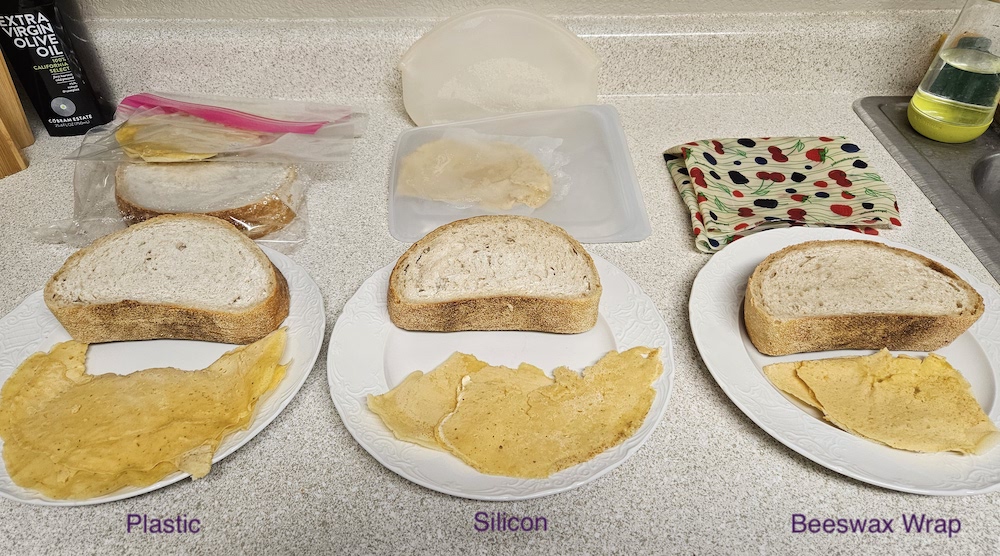This month’s plastic-free challenge is about finding alternatives to plastic wrap. At the beginning of the month, I froze bread and crepes using – silicone bags, beeswax plastic wrap, and a regular plastic bag to see how they compare to each other.
Now that it’s been 2 weeks, it’s time to see how the first batch of bread and crepes fared in the freezer.
Why am I using these plastic wrap alternatives in the freezer?
Silicone bags and beeswax wrap are frequently used as replacements for plastic wrap.These days I don’t use much plastic wrap except for in the freezer. But I would like to know what my options are for freezing foods. Hence the reason I’m testing frozen bread and crepes for this month.
Silicone is heat resistant so it shouldn’t have any problems in the freezer, unlike the predictions for the beeswax wrap. Beeswax wrap is temperature sensitive but mostly to heat, which is why I went ahead and tried it in the freezer. However, I’m mostly curious to see how the silicone compares to the regular plastic bag.
(If you would like to learn more about Beeswax wraps, Silicone, and fabric bowl covers, please check out my previous articles about what they are and how to use them.)
Here are my findings for the bread and crepes that had been frozen for 2 weeks:
| Plastic | Silicone | Beeswax Wrap | |
| Bread | Appearance – has ice crystals and freezer burn Taste – Good | Appearance – has ice crystals and freezer burn Taste – Good | Appearance – No ice crystals, has freezer burn Taste – Pretty good, a little bit drier than others |
| Crepes | Appearance – Looks good Taste – Really good | Appearance – a little bit of freezer burn Taste – Good | Appearance – some freezer burn Taste – Good |

- Unlike plastic and silicone, beeswax wrap does not provide an air-tight barrier. So it’s not surprising that it didn’t form ice crystals and the bread was a bit drier.
- There wasn’t much difference for the breads and they all had freezer burn. The plastic and silicone did a little bit better than the beeswax wrap.
- The crepes did better with the plastic but the other options, even the beeswax wrap, came out fairly well.
What about the rice ball test?
Besides freezing foods, I also wanted to test rice balls this month. The way I usually make rice balls relies on plastic wrap to shape and store them. So, now’s the time to figure out an alternative.
Last weekend, I made rice balls using a silicone mold instead of plastic wrap. I was very impressed with the results. They were probably the best rice balls I’ve ever made! I also stored the rice balls in the fridge using beeswax wraps, glass/metal containers, and plastic wrap for comparison. On day 2 there were no discernible differences among the different storage types. By day 3, the beeswax wrap and glass container rice balls were marginally drier than the plastic wrapped one. By day 4, all the rice balls were getting dry.
So basically, any of the plastic wrap alternatives worked just fine to store the rice balls up to 2 days. Realistically though, you don’t want to store homemade rice balls much longer than 2 or 3 days regardless of the method. So you might as well go with the alternatives and cut down on single-use plastic waste.
What needs more testing?
I’ve recently learned that I haven’t been using my beeswax wraps to their full capacity. They are apparently well suited for storing cheese and salad. So I’m now testing these foods to see how the wraps compare to their plastic counterparts. I’ll include my thoughts and evaluations on these later in the conclusion article for this challenge.
Because there are 5 weeks in October, I’ll save this month’s conclusion post for the final week. That way I can give more freeze time to the rest of the foods I’m testing. In the meantime, I’ll cover a topic I’ve been wanting to examine for awhile now. Whether freeze-dried foods can really help with sustainability goals or not.
Looking for more tips on plastic-free storage? Plastic Free July has an article with some more plastic-free storage ideas.

